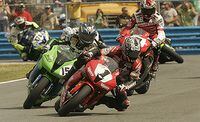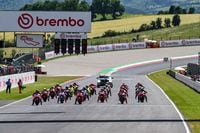When the pressroom interviews ended after Steve Rapp's sensational upset win in the Daytona 200, I headed for my rental car. Instead of being locked in traffic until 7 p.m., I was soon out through the tunnel. Where was the legendary Daytona crowd? It was a very light year—adding another element to my confused feelings about this once-dominant event. At one point during Bike Week I had scanned the vast grandstands and saw three spectators. Confused, that's what I am.
Many others have shared my confusion in the past couple of years, as the AMA 1000cc Superbike race is no longer the Daytona 200. Tire concerns have caused the Speedway to feature 600 FX—a kind of “600 Superbike”—in the 200-miler. Just in case 1000cc Superbike needs a backup too, there is the Superstock 1000 event, which reaches the same high top speeds but runs 13 laps instead of Superbike's 15, while on the shortened course (yes, I know, the 200 used to be 57 laps) the 200-miler has become 68 laps of 2.95 miles each. Got that all straight?
The next source of confusion is to wonder which class is supposed to be hot, and why. Superbike, featuring built-to-the-limit factory engines with CNC-milled porting, $30,000 super-trick forks and the usual $12,000 not-for-us coolant radiators, averaged 107 mph over 44 miles. Earlier, Superstock, featuring 1000cc engines essentially unmodified save for seat blend valve jobs, and with “obsolete” 17-inch tires, averaged 106.3 mph over 38 miles. Would you pay one million dollars to go 7/10 of one mile per hour faster? Daytona is supposed to be the big draw for The Breed with the Need for Speed. Is 7/10 of a mile per hour all that technology can squeeze out?I asked independent team owner Kevin Erion about this. He said that back when the Honda 900RR came on the market, “We could give our customers 15 extra horsepower with camshafts and some other changes. Now the stock bikes are so good, it's hard to find anything the factory has overlooked.”
As if to underline and double-underline what he had said, the events at Daytona this year showed hardly any difference in lap times between the limited-mods classes (600 Supersport and 1000 Superstock) and the corresponding almost-anything-goes classes (600 Formula Extreme and 1000cc Superbike).
Our own Road Test Editor Don Canet, long-time AMA Pro license holder, rode in this year's 22-lap 600 Supersport event. He started 43rd and finished 29th on a new Erion-prepared 2007 Honda CBR600RR. Roger Lee Hayden on one of the also-new Kawasaki ZX-6Rs won this event, with his individual laps averaging to 1:42.559, rolling along on DOT-spec non-slick Dunlops. To compare this with lap times in the featured 200-mile 600 FX race, I took the race time, subtracted a minute from it to allow for the delay of two pit stops, and divided by 68 laps. That gave me an average lap time of 1:43.6—distinctly slower than R.L.'s Supersport time. Okay, let's double our pit-stop allowance and subtract two minutes from the 200 time. That gives us an average lap time of 1:42.72—still not good enough to win the Supersport race. See why I'm confused?

/cloudfront-us-east-1.images.arcpublishing.com/octane/K5ZSQFMYQZHWRFXTTW4PEWMUDM.jpg)
/cloudfront-us-east-1.images.arcpublishing.com/octane/D2SOSBIQQRBPTERNSOJRAW3KYY.jpg)
/cloudfront-us-east-1.images.arcpublishing.com/octane/DS3Q5X2VJFFAJDK2PWB3Y7K6U4.jpg)
/cloudfront-us-east-1.images.arcpublishing.com/octane/4KBL4JAMYRFDPEINTWATDUH7OM.jpg)
/cloudfront-us-east-1.images.arcpublishing.com/octane/FXADK3MVSNBRTKJ2B7TPDCCJ5Y.jpg)
/cloudfront-us-east-1.images.arcpublishing.com/octane/M7L2CPXO55FRFMECW7QGDPGP6E.jpg)
/cloudfront-us-east-1.images.arcpublishing.com/octane/T4RWGLAEHVE2VCJZOTFTNGB2KA.jpg)
/cloudfront-us-east-1.images.arcpublishing.com/octane/JM4QGLAHWNGHPM74OEB7FVBFSY.jpg)
/cloudfront-us-east-1.images.arcpublishing.com/octane/BGPNXPDDYBHD3HL6YEZQOYHXTI.jpg)
/cloudfront-us-east-1.images.arcpublishing.com/octane/SND5GGQV4RDPPMZBSBEGIZ4SIY.jpg)
/cloudfront-us-east-1.images.arcpublishing.com/octane/XUDDAPYZMZEL5EDPVDJ2DTULWI.jpg)
/cloudfront-us-east-1.images.arcpublishing.com/octane/M7AU2L6GAVCJVHW57LIRPDAAUQ.jpg)

/cloudfront-us-east-1.images.arcpublishing.com/octane/JKEJY7P43JGD5C5NJO2VJQJPUM.jpg)
/cloudfront-us-east-1.images.arcpublishing.com/octane/YROKYJYUQVGPHCEMPTGBWDQCKQ.jpg)
/cloudfront-us-east-1.images.arcpublishing.com/octane/QIHEYR66TZDAPCGMWHCWCBC4XA.jpg)
/cloudfront-us-east-1.images.arcpublishing.com/octane/4FTBMNZL5BD2ZHY62XXRHJW6PI.jpg)
/cloudfront-us-east-1.images.arcpublishing.com/octane/L2BHKRCEMFDF7O3S4REZXPDH2E.jpg)
/cloudfront-us-east-1.images.arcpublishing.com/octane/QHENIV3HMJCTTCXQ6O5YPTNRZ4.jpg)
/cloudfront-us-east-1.images.arcpublishing.com/octane/K3VNQBIAKVGIHIGBRG7QKJYLVI.jpg)
/cloudfront-us-east-1.images.arcpublishing.com/octane/HRU64QXT3NH2DJOFBVI53XIKCE.jpg)
/cloudfront-us-east-1.images.arcpublishing.com/octane/4C5HHSNJCVDZXPIJTCJBVTE2MU.jpg)
/cloudfront-us-east-1.images.arcpublishing.com/octane/HBKK2TCOCZFIBIVKLKZFF5NXLQ.jpg)
/cloudfront-us-east-1.images.arcpublishing.com/octane/23S5ZEY2FBBADHQQK7AKLFDNYM.jpg)